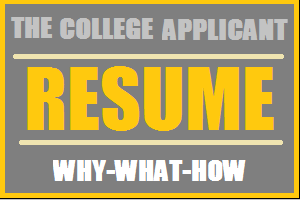A resume, like all other application documents, is designed to answer one crucial question: “Why should you be selected?” Of all the application documents (the SOP, the recommendation letters, and the transcripts), the resume answers that question in the briefest yet most comprehensive way. In order to achieve its goals, the resume must present the most important facts about you in their most concentrated form, in the smallest possible space. This will enable it to present a compelling snapshot of your strengths as a candidate and persuade the Admissions Committee that you are a good choice. Here are some tips that will help your resume to achieve its intended goals:
- Highlight achievements by providing specific details and quantifying them wherever possible
- Use numerals rather than words especially in talking of percentages, ranks, class strengths
- Be brief – use abbreviated sentences rather than full ones; if possible, try to squeeze your information into a single page
In other words (to illustrate all the above):
- Write: “1st prize, Mechxpo 2013 for ‘Robotic Arm for Assembly Line’ (final year project)”
- Do NOT write: “I was awarded the first prize for my final year project titled ‘Robotic Arm for Assembly Line’ in Mechxpo 2013”
Further, use bullet points to break up large chunks of text into small easily comprehensible points. For example, it is much easier to read the following:
- Applied ergonomic criteria to analyse worker fatigue and reduced productivity
- Automated the process, resulting in a 233% increase in job tightening rate from 18 to 60 jobs/hour
- Used critical path analysis and PERT techniques to finish project 10 days before submission deadline and within budget
- Applied ergonomic criteria to analyse worker fatigue and reduced productivity. Automated the process, resulting in a 233% increase in job tightening rate from 18 to 60 jobs/hour. Used critical path analysis and PERT techniques to finish project 10 days before submission deadline and within budget
Finally, proofread:
- Check spelling mistakes
- Capitalize only when necessary i.e. avoid capitals for the names of subjects you have studied (e.g. computer architecture, digital signal processing), or hobbies (e.g. trekking, listening to music) etc.
- Capitalize uniformly i.e. write ‘Chemical Engineering’ or preferably ‘chemical engineering’; do NOT write ‘Chemical engineering’ or ‘chemical Engineering’
- Find out how standard academic journals in your field write titles (some capitalize only the first letter of the title, some italicize the whole title etc.), but in general remember that words like ‘in’, ’of’, ‘to,’ ‘and’ are not capitalized except when they are in the beginning of a title.
- Use full forms not abbreviations for degrees – i.e. write ‘Bachelor of Engineering’ and not ‘BE’, ‘Engineering’ rather than ‘Engg.’ and ‘and’ instead of ‘&’ (those short forms irritate American professors)
- Use past tense in general e.g. “Designed, assembled and installed fixture mechanism for setting rolling machine plates” or “carried out the QS-9000 documentation up to the pre-production stage of axle assembly”
- Use present tense only for ongoing education, projects, responsibilities etc.”oversee the production of prototypes of rear and front axle assemblies for passenger cars and multi-utility vehicles right from the stage of studying the component drawing sheets up to the final assembly of the prototype components”
Links:

